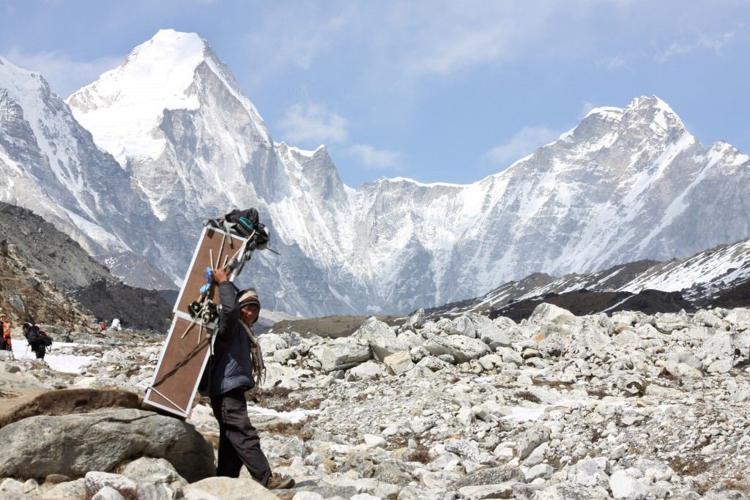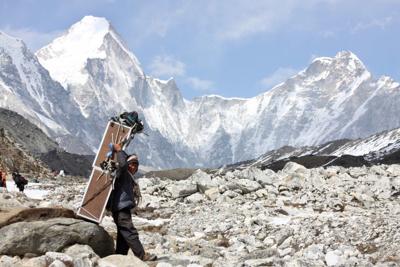After years of being weighed down by material possessions, Doug Hatfield decided to lighten up.
Hatfield is an active member of the Colorado Mountain Club. He’s climbed all 54 Colorado fourteeners and most of the highest thirteeners. He knows the tricks of winter camping and high-altitude mountaineering. But he hadn’t figured out how to pack an overnight backpack that weighed less than 40 pounds.
“I realize I need help,” he said one evening as he lugged his bag to meet Greg Long, one of the club’s gurus of light backpacking. They’d agreed to meet with full backpacks and weigh them, then compare gear, piece by piece, to see how Hatfield could lighten up.
“OK, let’s put it on the scale,” Long said of Hatfield’s bag.
Hatfield grunted as he balanced a bulging Gregory pack on a bathroom scale: 43 pounds.
“Now, let’s do mine,” said Long: 18 pounds.
“No way! You must not have anything in there,” Hatfield said.
“I bet I have everything you have. At least everything you really need,” Long said. “Unpack and let’s see.”
Backpackers say lightening up is the key to making camping less of a grunt. With light packs, shoulders and feet don’t ache. Hikers can go farther and see more. Backpackers increasingly are interested in shedding pounds. Long the concern of through-hikers, trekkers and gear geeks, even weekend backpackers have joined the game of shaving ounces. Jacket makers, pack makers, stove makers — almost every manufacturer has ultralight models.
Not that long ago this gear was fairly unknown. “Now, it’s everywhere,” said Long.
Well, everywhere but Hatfield’s pack.
Among friends, he is known as a good packing partner because if you forget something, chances are he has an extra. On a three-day trip up Pikes Peak, he brought a 5-pound bag of gummy bears he never ate and four pairs of gloves.
“I was a Boy Scout,” he said in defense. “I go prepared.”
On his summer packing list he dropped a pair of gloves.
“Why do you have so many gloves?” Long asked.
“My hands might get cold,” Hatfield said.
“Have you ever, ever used all these gloves in the summer?” Long asked.
Long threw two pairs of Hatfield’s gloves in a growing pile of extra gear, which included an extra knife, several batteries, a jacket, a camp pillow, a bulky pair of sandals, a large, steel pot, and a pair of long johns. In all, the piles weighed 6 pounds.

It’s nice to think you can survive on gorp, but the truth is you’ll probably feel better and be better fueled by cooking some meals. Many backpackers consider a lightweight stove an essential. (The Gazette file)
LOCAL MOVEMENT
The trend toward light backpacking traces its roots to a kid named Ray Jardine who grew up in Colorado Springs in the 1950s. Jardine was a voracious hiker and explorer. He climbed Pikes Peak at least 50 times growing up. He became a NASA engineer, then a climbing equipment designer. He started doing thousand-mile hikes, which led to an interest in how to cut weight.
In 1996, he nailed the ultralight manifesto to the door of orthodox backpacking by writing the book “Pacific Crest Trail Hiker’s Handbook.” It was republished in 1999 as “Beyond Backpacking.”
For years, manufacturers had been adding bells and whistles to gear. Extra zippers, heavy duty fabric, and bombproof construction sold great but was murder on backs, legs and feet on the trail. Jardine said enough. “Beyond Backpacking” laid out the lessons learned carrying a 9-pound pack 2,700 miles on the Pacific Crest Trail, and became the basis of the ultralight philosophy:
GRADUAL TRANSITION
Long carries a backpack made by GoLite, a now-defunct Boulder-based company Jardine co-founded in 1998. The pack weighs about a pound. Hatfield’s pack made by Gregory weighs about 6 pounds.
Mike Miller, a long-time employee of outfitter and gear retailer Mountain Chalet in downtown Colorado Springs, said people can cut pounds of weight just by re-examining their “big three”: pack, sleeping bag and tent.
“Until they talk with one our employees, they don’t realize just how much weight they really can get rid of,” he said. It can mean buying new gear, but ultralight gear is usually fairly basic, so the prices are not too steep.
“You can drop 4 to 5 pounds off a pack and you don’t need a loan to purchase them,” Miller said.
Every time Long buys a piece of gear, he considers weight. If he can get a lighter piece for the same price, he does it. If he needs to spend a little more, he considers it.
“You don’t have to do it all at once, but if you replace things as they wear out with lighter gear, eventually, you’ll get there.”
Long pulled everything out of his pack. He wanted to show that you can be light and still prepared. Often people equate going light with leaving critical items at home and hoping everything turns out fine. When it doesn’t, the lack of gear can spell disaster.
Long doesn’t take chances. His bag has everything Hatfield’s had — minus the extras. But most of it is the lightest on the market. He has read Jardine’s books. He has put all of his gear on a kitchen scale to scrutinize it down to the ounce. He has trimmed the fat.
“You really have to analyze everything. Why do you need a fork, knife and spoon when everything you ever eat while backpacking only requires a spoon?” he asked.
Hatfield conceded the point, but he looked a little dejected when Long said a small camp pillow is also an extra.
At the end of the session, they packed up. Had Hatfield reached enlightenment?
“Well, I’m getting there,” he said. “But it may take awhile.”









(0) comments
Welcome to the discussion.
Log In
Keep it Clean. Please avoid obscene, vulgar, lewd, racist or sexually-oriented language.
PLEASE TURN OFF YOUR CAPS LOCK.
Don't Threaten. Threats of harming another person will not be tolerated.
Be Truthful. Don't knowingly lie about anyone or anything.
Be Nice. No racism, sexism or any sort of -ism that is degrading to another person.
Be Proactive. Use the 'Report' link on each comment to let us know of abusive posts.
Share with Us. We'd love to hear eyewitness accounts, the history behind an article.